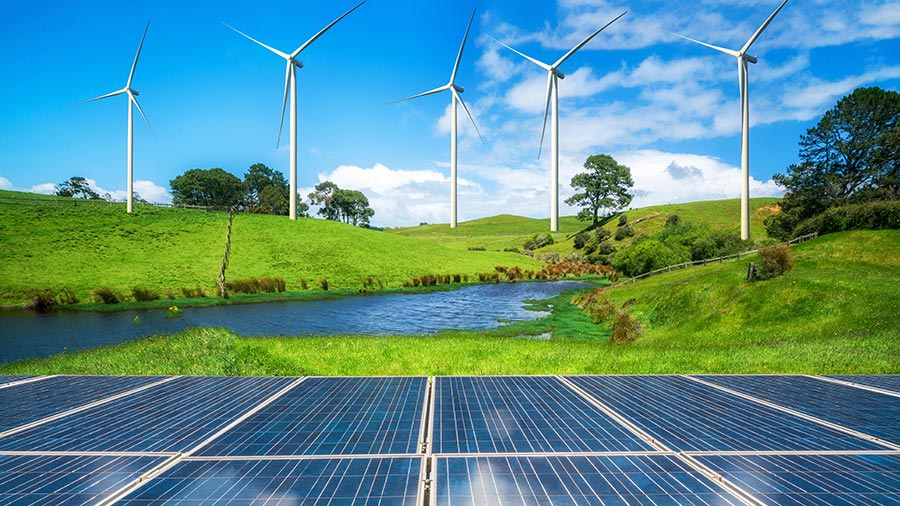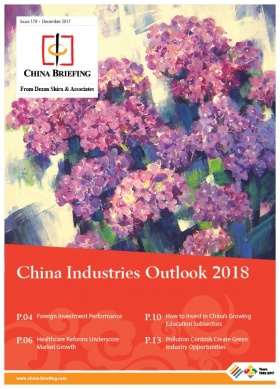Investing in China’s Green Industries
After US President Donald Trump announced the US would pull out of the Paris climate agreement, French President Emmanuel Macron stated “Now China leads.” China is currently the world’s largest polluter – what was Macron thinking?
China has fully embraced renewable energy and clean technology to solve its pollution problem; the country is now global leader in emerging green industries. The government has consistently demonstrated its willingness to invest heavily in green industries to resolve its pollution problem and support green industries with investment incentives and preferential policies.
China’s clean energy sector: Scope for investments
Indeed, the Business and Sustainable Development Commission (BSC) recently reported that businesses stand to gain a combined US$2.3 trillion from solving China’s various environmental issues. These opportunities are not evenly spread across every green industry, however.
While China is actively encouraging foreign investment in a number of green industries, domestic companies completely dominate others.
Further, participation in such industries can come at the cost of revealing proprietary technology and knowledge.
As a result, foreign investors looking to capitalize on China’s environmental leadership must have a thorough understanding of where opportunities exist, and how to make secure investments.
Solar and wind power
The world’s largest floating solar plant was launched in Anhui province in May; the world’s largest solar farm was put in motion in Qinghai province earlier this year.
China is the largest producer of solar energy in the world, hitting 77.42 gigawatts of solar power capacity by the end of 2016. Under China’s 13th Five Year Plan covering the years 2016-2020, China aims to have 110 gigawatts of solar capacity installed by 2020.
China is also the biggest producer of wind power, installing 23.3 gigawatts of wind power turbines in 2016 to reach a total capacity of 169 gigawatts. Globally, 54.6 gigawatts were newly installed in 2016. China targets to have 250 gigawatts of wind power capacity by 2020, and 495 gigawatts by 2030.
China has encouraged foreign investment in solar and wind technology to help the country reach its ambitious capacity targets. There are a variety of incentives in place, such as reduced corporate income tax (CIT) rates for installing wind power in the country’s western regions.
In practice, however, foreign investors may find it difficult to compete with Chinese companies in these industries. According to the New York Times, six of the world’s top 10 solar panel makers are Chinese, including the top two. China manufactures about two-thirds of the world’s solar panels, and half the world’s wind turbines.
Given that China has several established and capable companies capable of manufacturing and installing solar panels and wind turbines, local governments are more likely to purchase from a domestic company than a foreign one. Indeed, domestic entities control 98 percent of China’s wind power market.
Foreign companies can still compete with advantages in technology, efficiency, and expertise, however, making them attractive for joint ventures with Chinese partners or allowing them to sell directly to private entities. For example, the Belgian marine engineering company DEME recently entered into a joint venture with COSCO shipping, a Chinese SOE, to develop offshore wind farms.
There are also opportunities for foreign investors in associated fields, such as power grids. Much of the clean energy China produces is lost to curtailment, due in large part to outdated power grids. At least 17 percent of China’s wind energy was lost to curtailment in 2016, including 43 percent in Gansu province and 38 percent in Xinjiang.
Foreign expertise in the development of smart grids – electric grids that use big data and advanced technology to more reliably and efficiently deliver electricity – is needed for China to capture the clean energy it creates. US engineering conglomerate Honeywell is one such firm that has participated in developing smart power grids in China.
Electric vehicles
China is the world’s largest electric vehicle market, registering 352,000 new electric vehicles in 2016. China’s auto market is also the world’s largest, and electric vehicles now represent about 1.2 percent of the total market.
Both China’s auto market is highly protected, including the electric vehicle market. Domestic companies make up 93 percent of electric vehicle sales, while Tesla controls six percent, leaving just one percent for the rest.
Despite the dominant market share, China has struggled to develop internationally recognized auto brands, and consumers in the country consider foreign autos more prestigious. Foreign brands can therefore leverage their advantages in brand reputation and technology to access the Chinese market and cater to higher-end consumers.
Volkswagen and JAC have formed a joint venture to produce 100,000 electric vehicles a year in China, while General Motors has announced that it will produce hybrids in the country.
Beijing is supporting this drive by establishing five million charging stations by 2020 and 80 million by 2030. The upcoming revision to the Catalogue for the Guidance of Foreign Investment Industries is expected to allow 100 percent foreign ownership in electric car battery companies.
Urban planning
China’s historic development and urbanization resulted in an unprecedented construction and housing boom, with over 500 million people moving from rural areas to cities since the 1980s. Cities across China have struggled to accommodate this influx of new city dwellers, and BSDC estimates that over 107 urban households in China live in substandard housing.
In April, President Xi Jinping announced that the Xiongan New District would be developed to handle Beijing’s excess industrial capacity, showing that China still faces immense urban planning challenges. In 2016, the State Council revealed that it is planning to construct 3,500 new urban areas by 2030, capable of housing an incredible 3.4 billion residents.
These new urban planning initiatives have a clear green focus. The New Type Urbanization Plan for 2014-2020 requires green buildings to comprise 50 percent of new constructions by 2020, up from just two percent in 2012. Green buildings – generally defined as capable of conserving resources, protecting the environment, and reducing pollution – enjoy preferential policies, such as building subsidies and reduced CIT rates.
Green construction is a priority for the Chinese government because the country’s breakneck urbanization and construction has led to severe waste and environmental degradation. Only five percent of China’s construction waste is recycled compared to 90 percent in the EU and 97 percent in Japan and South Korea. Meanwhile, the government classifies 61.5 percent of groundwater and 28.8 percent of key rivers as “not suitable for human contact”.
To handle the waste created by urbanization – including garbage, e-waste, industrial waste, and sewage – China has encouraged recycling and wastewater treatment, among others, for foreign investment.
As regional governments award most urban planning projects, foreign companies may struggle to compete with domestic competitors. However, foreign technology and expertise is desperately needed to solve pressing issues faced by municipalities across China, creating opportunities for joint ventures and other forms of partnerships.
Opportunities for foreign investment
The US exit from the Paris agreement has thrust China into the position of global climate leader. However, while China has devoted trillions of dollars to tackling its myriad environmental issues, transforming from the world’s biggest polluter to a clean energy champion is an immense task.
Almost 70 percent of China’s energy still comes from coal, and vast swathes of land are highly polluted. Environmental concerns are the biggest cause of public protests in China, and regional governments face a variety of practical environmental challenges. However, as economic growth slows, there could be increasing reluctance to give up cheap sources of energy.
While domestic companies dominate many green industries, and some green industries are blocked or partially blocked to foreign investment, the scope and challenges of China’s green push present considerable opportunities for foreign investors. Successfully capitalizing on the opportunities presented, however, requires careful due diligence of opportunities and reliable partners, as well as the safeguarding of proprietary technology and intellectual property.
About Us
China Briefing is produced by Dezan Shira & Associates. The firm assists foreign investors throughout Asia and maintains offices in China, Hong Kong, Indonesia, Singapore, Russia, and Vietnam. Please contact info@dezshira.com or visit our website at www.dezshira.com.
- Previous Article China’s New VAT Fapiao Requirements to Affect Taxpayers, Service Providers
- Next Article The NEEQ: A Stock Market for SMEs in China








